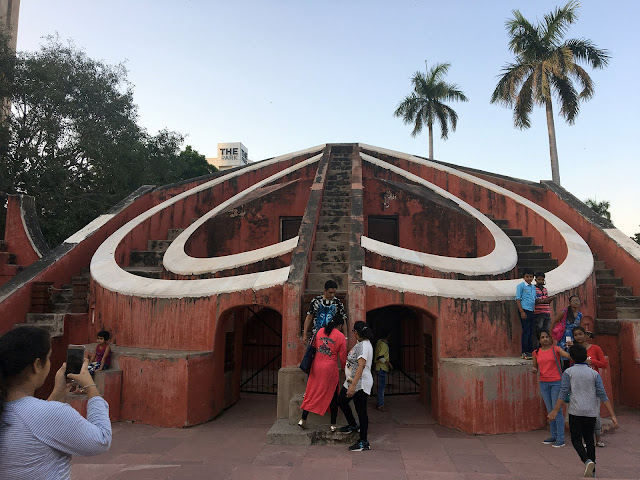 |
| Mandana in a village home, Bundi |
I had a chance
to visit a small village outside of Bundi, Rajasthan on October 5, which
happened to be Sharad Purnima, the day of the Ashvin full moon. I learned that
this is a date of great spiritual significance, particularly among farmers and
villagers, as it marks the end of the monsoon season and an auspicious harvest
time. The occasion is observed by fasting and devotion to the goddess Lakshmi;
at night in some places, a bowl of kheer (milk with rice and dried fruit) is
placed outside with a cloth cover so that it can absorb the moon’s healing
light rays. The milk is later consumed while looking at the moon. We arrived at
the village shortly after moonrise; we walked through basmati rice fields under
the full moon, were served chai, introduced to a baby buffalo just born the day
before, shown beautiful shrines and fruit trees.
 |
| Village shrine, Bundi |
 |
| Village home with concrete construction, Bundi |
Villagers with papaya tree and garlic harvest, Bundi
Early October is
the wrong time to look for Mandana drawings in the villages outside of Bundi.
This is because Diwali celebrations occur on October 19 this year, and the days
and weeks leading up to Diwali are when villagers spend time cleaning,
repairing, and beautifying their traditional homes. Traditionally villagers
construct their abodes and outbuildings from natural materials – a mixture of
mud, straw, and cow dung, with woven straw or clay tile roofing. The structures
are quite resilient and strong but must be rebuilt each year. Walls and roofs
are rebuilt or repaired; floors are resurfaced with mud and dung.
Once structures
have been repaired and finished, village women traditionally complete the final
stages by beautifying their homes by creating Mandana. With a
mixture of rice flour or chalk and water, a paste is created and used to paint
elaborate patterns on the outer walls, floors, and thresholds. These patterns
are said to purify, ward off evil, and invite gods and goddesses into the
domestic space. In Rajasthan the drawings are
called Mandana; other regions use different terms for the practice, such as Aripan
or Alpana (Mithila region), Kolam (Tamil Nadu), or Rangoli/Rangavali (Karnataka,
Maharashtra). In some regions the drawings are created only on auspicious
occasions such as festivals and weddings; in others, women create fresh
drawings on their thresholds every morning. The Mandana in south Rajasthan
corresponds to the seasonal cycle of renewal and the Diwali festival.
When I visited
the Bundi village, floors and walls were being repaired and freshly coated with
mud and dung; most traces of Mandana had been cleared away in preparation for
new work. I found an exception inside one village home – a set of lovely
circular and triangle floor paintings that had not yet completely worn away. As
concrete materials increasingly replace the traditional mud and dung floors and
walls of homes, women have had to use new materials such as oil enamels to
create Mandana; some have given up the practice altogether, as concrete
surfaces no longer require the annual refurbishing and repainting that Mandana
accompanies.
 |
| Mandana in a village home, Bundi |
 |
Mandana in a village home, Bundi

Mandana in a village home, Bundi |
 |
| Mandana in a village home, Bundi |
I love the
ephemerality of these paintings – as they age and wear away, old patterns are
crossed and layered with the patterns of daily human and animal activity. They
are executed with mastery and are exceedingly beautiful, yet there is no
attachment or attitude of preciousness surrounding them.
Even in the few
samples I observed there was great variety of form and pattern. While in some
forms of Kolam different shapes have different meanings, I was told that
Mandana patterns, at least in this village, were made purely for their beauty
and as expressions of devotion. I asked some women about how they learned to
create them. Is there a book of patterns? Do you practice them as children? Study
them in school? I was told that for these women, the patterns are not taught;
they are ‘already in them when they are born’.




































